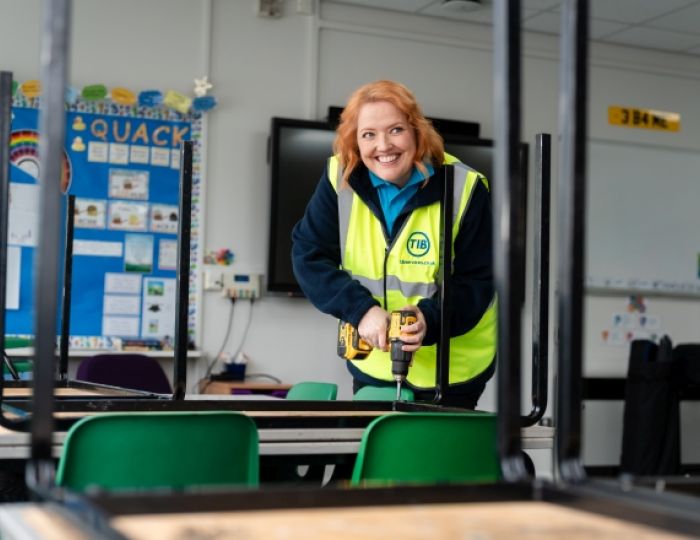To describe the last 12 months as a ‘challenge’ for schools would be an understatement.
Where school staff may have been confronted with those bet-it’s-like-a-long-summer-holiday-style comments at the start of the first national lockdown, fast forward to today and there seems to be far greater understanding and respect for the unprecedented challenges teachers and leaders have faced while trying to ensure learning and support continues no matter the circumstances.
But this isn’t the only shift in attitudes since the pandemic. In December 2019 – a few months before the pandemic truly took hold in Britain – the world’s learning company Pearson surveyed over 1,000 UK teaching staff for their views on mental health and wellbeing. At that time, when it came to building a happy and healthy school, those teachers considered the three most important things to be pupil mental wellbeing (59 per cent), staff mental wellbeing (46 per cent) and a safe environment (41 per cent).
When asked this question in summer 2020, following the outbreak of COVID-19, teachers rated a safe environment above their own staff mental wellbeing. While it feels quite right to prioritise school safety around Coronavirus, these two points feel like they could well be inextricably linked: a safe school environment should involve good – and safe – mental health practices among its staff too.
Though the days of jetting off to sunnier climes may still be out of reach – anyone who’s ever travelled by plane will remember that all-important advice from the pre-flight briefing: In the event that this cabin loses pressure, remember to put on your oxygen mask before you begin to help others. It is vital – of course – that primary leaders and teachers do all they can to help the children in their care with their wellbeing, especially given the formative nature of early years education. But they must also practice what they preach.
Responses to the Guardian’s call for teachers to share their work experiences at the end of last year indicated a widespread downturn in teacher wellbeing, often sparked by feelings of isolation, and the pressure of supporting vulnerable children. Words like ‘stress’, ‘disillusionment’ and ‘manic’ came to the fore, tallying with the survey results from Pearson, in which more than half of respondents reported that their mental health and wellbeing had been negatively impacted by the pandemic.
If these findings chime with you or your school, what can you do from here? Here are a few techniques and considerations to help build healthier and happier schools.
Have courage in your convictions and planning
As leaders and teachers navigate another year of announcements and changes in education due to the pandemic, it is natural to doubt your decisions and approaches occasionally. Where self-reflection and awareness can be healthy qualities, too much self-doubt on the other hand can be damaging.
Remember that you and your school staff are the experts when it comes to teaching and learning. So draw on what you already know, what you’ve already experienced and the tools and approaches that work for you and your staff and have courage in your convictions.
Planning can also provide a great deal of reassurance. While many leaders will have already planned for the possibility of further school closures and changes, it’s still not too late to review the Education Endowment Foundation’s Guide to Supporting School Planning. It has been developed with expert school leaders from across the country and includes strategies, evidence and approaches to handling the unpredictable, as well as signposts to further support.
Flip the narrative
Talk of learning loss and the negative effects of the pandemic can feel hard to escape in the news these days. So it’s even more important to watch the phrases and messaging that you use with your school community. Some schools I’ve spoken to find that terms like ‘catch up’ and ‘closing gaps’ are loaded with negative connotations and causing anxiety for teachers and learners alike.
Turn this on its head and start using terms like ‘accelerated learning’, ‘levelling up’ and ‘getting back on track’ to reinforce more positive messages and phrases in the staffroom and classroom, ultimately creating a more supportive environment for everyone in your school.
Work together
In a period marked by social distancing, and self-isolation, it’s vital to stay connected and to remember that you aren’t alone. Encourage school staff to come together, to talk openly about any challenges they’re facing and to work together on developing strategies to support and overcome them.
This can be achieved in a variety of ways. You might use staff meetings, in-person or virtually, which are focused on personal and emotional support or introduce teaching buddies – another member of teaching staff to confide in or let off steam or planning activities with staff. Always ensure open channels of communication so that concerns are heard and seek further support if needed from the likes of Education Support, a UK charity dedicated to supporting mental health and wellbeing among educators.
Encourage mindfulness
Mindfulness is the practice of training the mind to enhance our awareness of our thoughts, feelings and sensations. It can help by increasing attention span, concentration and emotional resilience throughout periods of uncertainty, when it’s common for stress and anxiety to build up. Knowing particular skills and techniques to manage stress and anxiety can help you and your teachers to improve resilience and overall mental health. Try and share the techniques in Pearson’s free Mindfulness for Unsettling Times guide which supports teachers to practice mindfulness along with their students.
Look out for burn out
Any teacher suffering from stress is likely to find it hard to deliver their best in the classroom. Although it can be tough to enforce, it’s so important to foster a positive work-life balance culture in your school and to lead by example.
Staff need to be encouraged to switch off when they’re not at school, establish non-work activities as part of their routines and feel that they can request time off when they’re under the weather and have managers and leadership teams who are promoting wellbeing and avoiding staff burnout.
Ultimately, amidst all of the chaos and changes, educators must remember that they will be little help to anyone if they cannot help themselves. Just keep thinking of that oxygen mask.
If you’re in need of a pick-me-up, take a step back and think about the little things that made you smile or the life-changing impact you make day-in, day-out to children’s lives - not to mention the revived devotion and gratitude from parents home schooling across the country.
On behalf of pupils, parents and carers everywhere: thank you for all that you do.
Ways to help wellbeing
- Have courage in your convictions and planning. Draw on Education Endowment Foundation’s Guide to Supporting School Planning for further support managing unpredictability.
- Flip the narrative and develop a stronger sense of positivity and support within the staffroom. Use phrases that have good associations (e.g. ‘accelerated learning’ rather than ‘catching up’) to brighten your school environment.
- Work together and find extra strength in the community around you. As educators, you can use your network to share strategies and experiences; even your classroom planning. A wealth of help and understanding is out there.
- Encourage mindfulness to increase your teachers’ emotional resilience, giving essential space for them to ground themselves. Try joining in with wellbeing exercises that have been developed for your pupils: you might be surprised at how helpful they are.
- Look out for burnout and foster a culture of positive work-life-balance, leading by example.
- Celebrate the little things and the impact you and your teachers make day-in, day-out.
Isla Billett is the Intervention Transformation Lead for Pearson’s UK Schools business, supporting learners and schools through these uncertain times, with a particular focus on accelerated learning and new initiatives for intervention. Isla has been a primary school governor for over eight years and is passionate about a truly inclusive curriculum supported by high-quality teaching and learning materials that reflect all of today’s learners and supports success for all. For further mental health and wellbeing support for schools, visit Pearson’s Wellbeing Zone: go.pearson.com/Wellbeing-Zone










